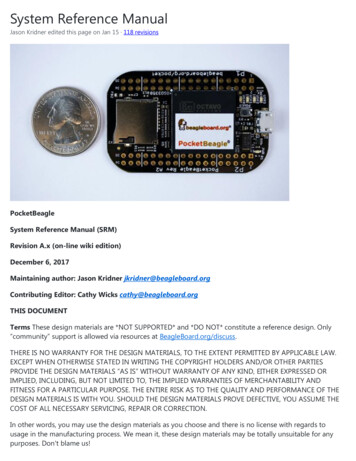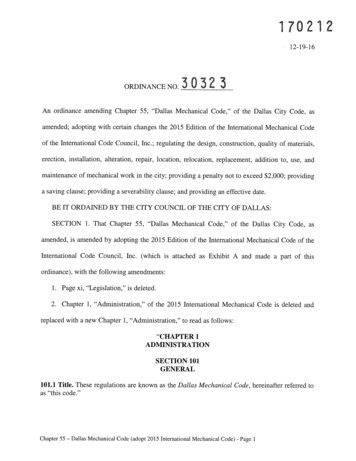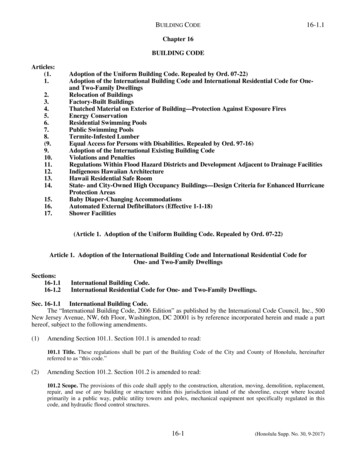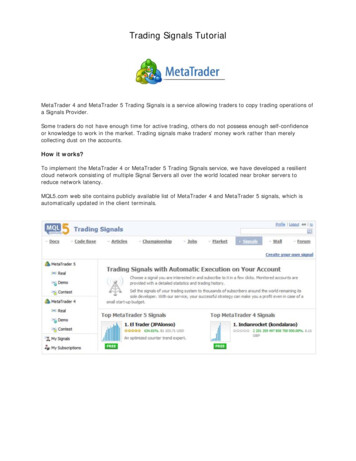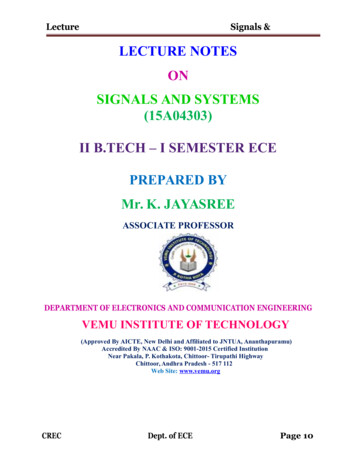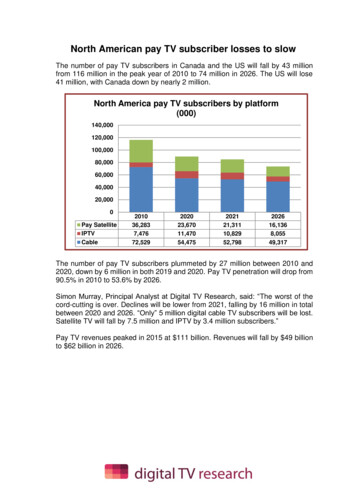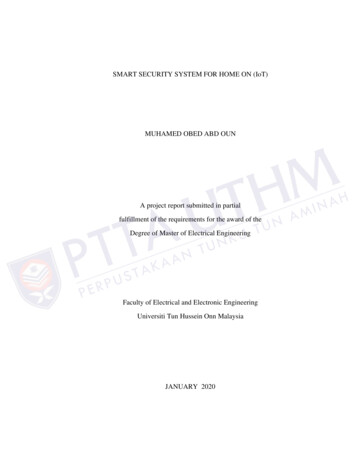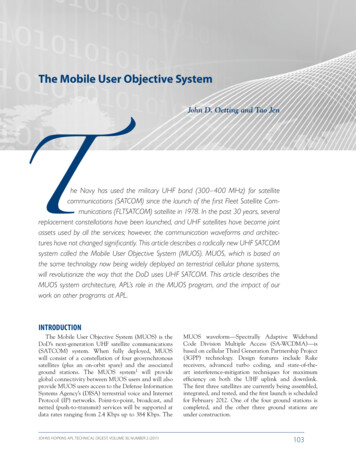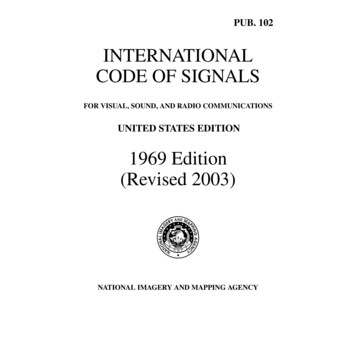
Transcription
PUB. 102INTERNATIONALCODE OF SIGNALSFOR VISUAL, SOUND, AND RADIO COMMUNICATIONSUNITED STATES EDITION1969 Edition(Revised 2003)NATIONAL IMAGERY AND MAPPING AGENCY
PUB. 102International Code of SignalsAs adopted by the Fourth Assembly of the Inter-Governmental MaritimeConsultative Organization in 1965For Visual, Sound, and Radio CommunicationsUnited States Edition, 1969(Revised 2003)Prepared and published by theNATIONAL IMAGERY AND MAPPING AGENCYBethesda, Maryland COPYRIGHT 2003 BY THE UNITED STATES GOVERNMENTNO COPYRIGHT CLAIMED UNDER TITLE 17 U.S.C.For sale by the Superintendant of Documents, U.S. Government Printing OfficeInternet: bookstore.gpo.gov Phone: toll free (866) 512-1800; DC area (202) 512-1800Fax: (202) 512-2250 Mail Stop: SSOP, Washington, DC 20402-0001
PREFACEPub 102, the 1969 edition of the International Code of Signals, became effective on 1 April 1969, and at that timesuperseded H.O. Pubs. 103 and 104, International Code of Signals, Volumes I and II. All signals are contained in a singlevolume suitable for all methods of communication.The First International Code was drafted in 1855 by a Committee set up by the British Board of Trade. It contained 70,000signals using eighteen flags and was published by the British Board of Trade in 1857 in two parts; the first containinguniversal and international signals and the second British signals only. The book was adopted by most seafaring nations.This early edition was revised by a Committee set up in 1887 by the British Board of Trade. The Committee’s proposalswere discussed by the principal maritime powers and at the International Conference in Washington in 1889. As a result,many changes were made. The Code was completed in 1897 and was distributed to all maritime powers. That edition ofthe International Code of Signals, however, did not stand the test of World War I.The International Radiotelegraph Conference at Washington in 1927 considered proposals for a new revision of the Codeand decided that it should be prepared in seven languages, namely in English, French, Italian, German, Japanese, Spanishand in one Scandinavian language which was chosen by the Scandinavian Governments to be the Norwegian language. Thenew edition was completed in 1930 and was adopted by the International Radiotelegraph Conference held in Madrid in1932. The new Code was compiled in two volumes, one for use by visual signaling and the other by radiotelegraphy. Wordsand phrases applicable to aircraft were introduced in Volume II together with a complete Medical Section and a Code foraccelerating the granting of pratique. The Medical Section and the pratique signals were prepared with the assistance andby the advice of the Office International d’Hygiene Publique. The Code, particularly Volume II, was primarily intended foruse by ships and aircraft and, via coastal radio stations, between ships or aircraft and authorities ashore. A certain numberof signals were inserted for communications with shipowners, agents, repair yards, etc. The same Conference (Madrid,1932) established a Standing Committee to review the Code, if and when necessary, to give guidance on questions of useand procedure, and to consider proposals for modifications. Secretarial duties were undertaken by the Government of theUnited Kingdom. The Standing Committee met only once in 1933 and introduced certain additions and amendments.The Administrative Radio Conference of the International Telecommunication Union suggested in 1947 that theInternational Code of Signals should fall within the competence of the Inter-Governmental Maritime ConsultativeOrganization (IMCO). In January 1959, the First Assembly of IMCO decided that the Organization should assume all thefunctions then being performed by the Standing Committee of the International Code of Signals. The Second Assembly in1961 endorsed plans for a comprehensive review of the International Code of Signals intended to meet the present dayrequirements of mariners. A Subcommittee of the Maritime Safety Committee of the Organization was established to revisethe Code, to prepare it in nine languages, namely the original seven (English, French, Italian, German, Japanese, Spanish,and Norwegian) together with Russian and Greek, and to consider proposals for a new radiotelephone Code and its relationto the International Code of Signals. The Subcommittee consisted of representatives of the following countries: Argentina,Germany, France, Greece, Italy, Japan, Norway, Russian Federation, United Kingdom, and the United States of America.The following international governmental and nongovernmental organizations contributed to, and assisted in, thepreparation of the revised Code: the International Atomic Energy Agency, the International Civil Aviation Organization,the International Labor Organization, the International Telecommunication Union, the World Meteorological Organization,the World Health Organization, the International Chamber of Shipping, the International Confederation of Free TradeUnions, and the International Radio Maritime Committee.The Subcommittee completed the revision of the Code in 1964, taking into account Recommendation 42 of the 1960Conference on Safety of Life at Sea and Recommendation 22 of the Administrative Radio Conference, Geneva 1959. TheCode was adopted by the Fourth Assembly of IMCO in 1965.The revised Code is intended to cater primarily for situations related essentially to safety of navigation and persons,especially when language difficulties arise. It is suitable for transmission by all means of communication, includingradiotelephony and radiotelegraphy, thus obviating the necessity for a separate radiotelephone Code and dispensing withVolume II for Radiotelegraphy. The revised Code embodies the principle that each signal has a complete meaning. It thusleaves out the vocabulary method which was part of the old Code. The Geographical Section, not being consideredessential, was omitted. By these means it was possible to reduce considerably the volume of the Code and achievesimplicity.Changes and corrections for this product will appear in the NIMA weekly Notice to Mariners and must be applied to keepit current. Users should refer information and comments to: MARITIME SAFETY INFORMATION DIVISION, ST D 44,NATIONAL IMAGERY AND MAPPING AGENCY, 4600 SANGAMORE ROAD, BETHESDA MD 20816-5003.iii
CONTENTSPAGECHAPTER 1.—SIGNALING INSTRUCTIONS . . . . . . . . . . . . . . . . . . . . . . . . . . . . . . . . . . . . . . . . . . . . . . . . . . . . .1CHAPTER 2.— GENERAL SIGNAL CODE . . . . . . . . . . . . . . . . . . . . . . . . . . . . . . . . . . . . . . . . . . . . . . . . . . . . . .27CHAPTER 3.—MEDICAL SIGNAL CODE . . . . . . . . . . . . . . . . . . . . . . . . . . . . . . . . . . . . . . . . . . . . . . . . . . . . . .105CHAPTER 4.—DISTRESS AND LIFESAVING SIGNALS ANDRADIOTELEPHONE PROCEDURES . . . . . . . . . . . . . . . . . . . . . . . . . . . . . . . . . . . . . . . . . . . .137APPENDIX: U.S./Russia Supplementary Signals for Naval Vessels . . . . . . . . . . . . . . . . . . . . . . . . . . . . . . . . . . . .151INDEXES . . . . . . . . . . . . . . . . . . . . . . . . . . . . . . . . . . . . . . . . . . . . . . . . . . . . . . . . . . . . . . . . . . . . . . . . . . . . . . . . . .153Index for Signaling Instructions and General Signal Code . . . . . . . . . . . . . . . . . . . . . . . . . . . . . . . . . . . . . . . . . . . .155Index for Medical Signal Code . . . . . . . . . . . . . . . . . . . . . . . . . . . . . . . . . . . . . . . . . . . . . . . . . . . . . . . . . . . . . . . . . .159v
CHAPTER1CHAPTER 1SIGNALING INSTRUCTIONSPAGESECTION 1: EXPLANATION AND GENERAL REMARKS . . . . . . . . . . . . . . . . . . . . . . . . . . . . . . . . . . . . . . . . .3SECTION 2: DEFINITIONS . . . . . . . . . . . . . . . . . . . . . . . . . . . . . . . . . . . . . . . . . . . . . . . . . . . . . . . . . . . . . . . . . . .4SECTION 3: METHODS OF SIGNALING . . . . . . . . . . . . . . . . . . . . . . . . . . . . . . . . . . . . . . . . . . . . . . . . . . . . . . .5SECTION 4: GENERAL INSTRUCTIONS . . . . . . . . . . . . . . . . . . . . . . . . . . . . . . . . . . . . . . . . . . . . . . . . . . . . . . .6SECTION 5: FLAG SIGNALING . . . . . . . . . . . . . . . . . . . . . . . . . . . . . . . . . . . . . . . . . . . . . . . . . . . . . . . . . . . . . . .9SECTION 6: FLASHING LIGHT SIGNALING . . . . . . . . . . . . . . . . . . . . . . . . . . . . . . . . . . . . . . . . . . . . . . . . . . .11SECTION 7: SOUND SIGNALING . . . . . . . . . . . . . . . . . . . . . . . . . . . . . . . . . . . . . . . . . . . . . . . . . . . . . . . . . . . .13SECTION 8: RADIOTELEPHONY . . . . . . . . . . . . . . . . . . . . . . . . . . . . . . . . . . . . . . . . . . . . . . . . . . . . . . . . . . . .14SECTION 9: SIGNALING BY HAND FLAGS OR ARMS . . . . . . . . . . . . . . . . . . . . . . . . . . . . . . . . . . . . . . . . . .15MORSE SIGNALING BY HAND FLAGS OR ARMS . . . . . . . . . . . . . . . . . . . . . . . . . . . . . . .15SECTION 10: MORSE SYMBOLS—PHONETIC TABLES—PROCEDURE SIGNALS . . . . . . . . . . . . . . . . . .17MORSE SYMBOLS . . . . . . . . . . . . . . . . . . . . . . . . . . . . . . . . . . . . . . . . . . . . . . . . . . . . . . . . . .17PROCEDURE SIGNALS . . . . . . . . . . . . . . . . . . . . . . . . . . . . . . . . . . . . . . . . . . . . . . . . . . . . . .20SINGLE LETTER SIGNALS . . . . . . . . . . . . . . . . . . . . . . . . . . . . . . . . . . . . . . . . . . . . . . . . . . .22SINGLE LETTER SIGNALS WITH COMPLEMENTS . . . . . . . . . . . . . . . . . . . . . . . . . . . . . .23SINGLE LETTER SIGNALS BETWEEN ICEBREAKER AND ASSISTED VESSELS . . . .241
CHAPTER 1SECTION 1: EXPLANATION AND GENERAL REMARKS1. The purpose of the International Code of Signals is to provide ways and means of communication in situations related essentially to safety of navigation and persons, especially when language difficulties arise. In the preparation of the Code, accountwas taken of the fact that wide application of radiotelephony and radiotelegraphy can provide simple and effective means ofcommunication in plain language whenever language difficulties do not exist.2. The signals used consist of:(a) Single-letter signals allocated to significations which are very urgent, important, or of very common use;(b) Two-letter signals for General Signal Code, Chapter 2, Pages 29 through 104;(c) Three-letter signals beginning with “M” for Medical Signal Code, Chapter 3, pages 107 through 135.3. The Code follows the basic principle that each signal should have a complete meaning. This principle is followed throughoutthe Code; in certain cases complements are used, where necessary to supplement the available groups.4. Complements express:(a) Variations in the meaning of the basic signal.Examples:“CP” “I am (or vessel indicated is) proceeding to your assistance.”“CP 1” “SAR aircraft is coming to your assistance.”(b) Questions concerning the same basic subject or basic signal.Examples:“DY” “Vessel (name or identity signal) has sunk in lat . . . long. . . .”.“DY 4” “What is the depth of water where vessel sank?”(c) Answers to a question or request made by the basic signal.Examples:“HX” “Have you received any damage in collision?”“HX 1” “I have received serious damage above the waterline”.(d) Supplementary, specific or detailed information.Examples:“IN” “I require a diver”.“IN 1” “I require a diver to clear propeller”.5. Complements appearing in the text more than once have been grouped in three tables. These tables should be used only asand when specified in the text of the signals.6. Text in brackets indicates:(a) an alternative, e.g.:“. . . (or survival craft). . .”;(b) information which may be transmitted if it is required or if it is available, e.g.: “. . . (position to be indicated if necessary)”;(c) an explanation of the text.7. The material is classified according to subject and meaning. Extensive cross referencing of the signals in the right-hand column is used to facilitate coding.3
CHAPTER 1SECTION 2: DEFINITIONSFor the purpose of this Code the following terms shall have the meanings defined below:Visual signaling is any method of communication, the transmission of which is capable of being seen.Sound signaling is any method of passing Morse signals by means of siren, whistle, foghorn, bell, or other sound apparatus.Originator is the authority who orders a signal to be sent.Identity signal or call sign is the group of letters and figures assigned to each station by its administration.Station means a ship, aircraft, survival craft, or any place at which communications can be effected by any means.Station of origin is that station where the originator submits a signal for transmission, irrespective of the method of communication employed.Transmitting station is the station by which a signal is actually being made.Addressee is the authority to whom a signal is addressed.Station of destination is that station in which the signal is finally received by the addressee.Receiving station is the station by which a signal is actually being read.Procedure denotes the rules drawn up for the conduct of signaling.Procedure signal is a signal designed to facilitate the conduct of signaling. (See Chapter 1, Section 10, Pages 17, 20, and 21.)Time of origin is the time at which a signal is ordered to be made.Group denotes more than one continuous letter and/or numeral which together compose a signal.A numeral group consists of one or more numerals.A hoist consists of one or more groups displayed from a single halyard. A hoist or signal is said to be at the dip when it ishoisted about half of the full extent of the halyards. A hoist or signal is said to be close up when it is hoisted to the fullextent of the halyards.Tackline is a length of halyard about 2 m (6 ft.) long, used to separate each group of flags.4
CHAPTER 1SECTION 3: METHODS OF SIGNALING1. The methods of signaling which may be used are:(a) Flag signaling, the flags used being those shown inside the front cover.(b) Flashing light signaling, using the Morse symbols shown in Chapter 1, Section 10, Page 17.(c) Sound signaling, using the Morse symbols shown in Chapter 1, Section 10 Page 17.(d) Voice over a loud hailer.(e) Radiotelegraphy.(f) Radiotelephony.(g) Morse signaling by hand flags or arms.Flag signaling2. A set of signal flags consists of twenty-six alphabetical flags, ten numeral pennants, three substitutes, and the answering pennant. Detailed instructions for signaling by flags are given in Chapter 1, Section 5, Pages 9 and 10.Flashing light and sound signaling3. The Morse symbols representing letters, numerals, etc., are expressed by dots and dashes which are signaled either singly orin combination. The dots and dashes and spaces between them should be made to bear the following ratio, one to another, asregards their duration:(a) A dot is taken as the unit;(b) A dash is equivalent to three units;(c) The space of time between any two elements of a symbol is equivalent to one unit; between two complete symbols it isequivalent to three units; and between two words or groups it is equivalent to seven units.4. In flashing light and sound signaling, while generally obeying the instructions laid down here, it is best to err on the side ofmaking the dots rather shorter in their proportion to the dashes as it then makes the distinction between the elements plainer.The standard rate of signaling by flashing light is to be regarded as forty letters per minute. Detailed instructions for signalingby flashing light and sound are given in Chapter 1, Sections 6 and 7, Pages 11 through 13.Voice over a loud hailer5. Whenever possible plain language should be used but where a language difficulty exists groups from the International Codeof Signals could be transmitted using the phonetic spelling tables.Radiotelegraphy and radiotelephony6. When radiotelegraphy or radiotelephony is used for the transmission of signals, operators should comply with the Radio Regulations of the International Telecommunication Union then in force. (See Radiotelephony in Chapter 1, Section 8, Page 14.)5
CHAPTER 1SECTION 4: GENERAL INSTRUCTIONSOriginator and addressee of message1. Unless otherwise indicated all signals between vessels are made from the Master of the vessel of origin to the Master of thevessel of destination.Identification of ships and aircraft2. Identity signals for ships and aircraft are allocated on an international basis. The identity signal may therefore indicate thenationality of a ship or aircraft.Use of identity signals3. Identity signals may be used for two purposes:(a) to speak to, or call, a station;(b) to speak of, or indicate, a station.Examples:“YP LABC” “I wish to communicate with vessel LABC by . . .” (Complements Table 1, Chapter 2, Section 10, Page104).“HY 1 LABC” “The vessel LABC with which I have been in collision has resumed her voyage”.Names of vessels and/or places4. Names of vessels and/or places are to be spelled out.Example:“RV Gibraltar” “You should proceed to Gibraltar”.How to signal numbers5. Instructions for signaling numbers:(a) Numbers are to be signaled as follows:(i) Flag signaling: by the numeral pennants of the Code.(ii) Flashing light or sound signaling: usually by the numerals in the Morse Code; they may also be spelled out.(iii) Radiotelephony or loud hailer: by the Code words of the Figure Spelling Table in Chapter 1, Section 10, Page 19.(b) Figures which form part of the basic signification of a signal are to be sent together with the basic group.Examples:“DI 20” “I require boats for 20 persons.”“FJ 2” “Position of accident (or survival craft) is marked by sea marker”.(c) A decimal point between numerals is to be signaled as follows:(i) Flag signaling: by inserting the answering pennant where it is desired to express the decimal point.(ii) Flashing light and sound signaling: by “decimal point” signal “AAA”.(iii) Voice: by use of the word “DECIMAL” as indicated in the Figure Spelling Table.(d) Wherever the text allows depths, etc., to be signaled in feet or in meters, the figures should be followed by “F” to indicatefeet or by “M” to indicate meters.Azimuth or bearing6. They are to be expressed in three figures denoting degrees from 000 to 359, measured clockwise. If there is any possibilityof confusion, they should be preceded by the letter “A”. They are always to be true unless expressly stated to be otherwise inthe context.Examples:“LW 005” “I receive your transmission on bearing 005 ”.“LT A120 T1540” “Your bearing from me is 120 at (local time) 1540”.6
SECTION 4.—GENERAL INSTRUCTIONSCourse7. Course is to be expressed in three numerals denoting degrees from 000 to 359, measured clockwise. If there is any possibilityof confusion, they should be preceded by the letter “C”. They are always to be true unless expressly stated to be otherwise inthe context.Examples:“MD 025” “My course is 025 ”.“GR C240 S18” “Vessel coming to your rescue is steering course 240 , speed 18 knots”.Date8. Dates are to be signaled by two, four, or six numerals preceded by the letter “D”. The first two numerals indicate the day ofthe month. When they are used alone they refer to the current month.Example:“D15” transmitted on the 15th or any other date in April means “15 April”.The two numerals which follow indicate the month of the year.Example:“D1504” means “15 April”.Where necessary the year may be indicated by two further numerals.Example:“D181063” means “18 October 1963”.Latitude9. Latitude is expressed by four figures preceded by the Letter “L”. The first two figures denote the degrees and the last twothe minutes. The letters “N” (North) or “S” (South) follow if they are needed; however, for reasons of simplicity they may beomitted if there is no risk of confusion.Example:“L3740S” “Latitude 37 40'S”.Longitude10. Longitude is expressed by four or, if necessary, five figures preceded by the letter “G”. The first two (or three) figures denote the degrees and the last two the minutes. When the longitude is more than 99 , no confusion will normally arise if the figureindicating hundreds of degrees is omitted. However, where it is necessary to avoid confusion the five figures should be used.The letters “E” (East) or “W” (West) follow if they are needed, otherwise they may be omitted, as in the case of latitude.Example:“G13925E” “Longitude 139 25' E”.A signal requiring the indication of position to complete its signification should be signaled as follows:“CH L2537N G4015W” “Vessel indicated is reported as requiring assistance in lat 25 37' N, long 40 15' W”.Distance11. Figures preceded by the letter “R” indicate distance in nautical miles.Example:“OV A080 R10” “Mine(s) is (are) believed to be bearing 080 from me, distance 10 miles”.The letter “R” may be omitted if there is no possibility of confusion.Speed12. Speed is indicated by figures preceded by:(a.) the letter “S” to denote speed in knots, or(b.) the letter “V” to denote speed in kilometers per hour.7
CHAPTER 1.—SIGNALING INSTRUCTIONSExamples:“BQ S300” “The speed of my aircraft in relation to the surface of the earth is 300 knots”.“BQ V300” “The speed of my aircraft in relation to the surface of the earth is 300 kilometers per hour”.Time13. Times are to be expressed in four figures, of which the first two denote the hour, from 00 (midnight) up to 23 (11 p.m.), andthe last two denote the minutes (from 00 to 59). The figures are preceded by:(a) the letter “T” indicating “Local time”, or(b) the letter “Z” indicating “Greenwich Mean Time”.Examples:“BH T1045 L2015N G3840W C125” “I sighted an aircraft at local time 1045 in lat 20 15' N, long 38 40' W flyingon course 125 ”.“RX Z0830” “You should proceed at GMT 0830”.Time of origin14. The time of origin may be added at the end of the text. It should be given to the nearest minute and expressed by four figures.Apart from indicating at what time a signal originated, it also serves as a convenient reference number.Communication by local signal codes15. If a vessel or a coast station wishes to make a signal in a local code, the signal “YV 1” “The groups which follow are fromthe local code” should precede the local signal, if it is necessary, in order to avoid misunderstanding.8
CHAPTER 1SECTION 5: FLAG SIGNALING1. As a general rule only one hoist should be shown at a time. Each hoist or group of hoists should be kept flying until it hasbeen answered by the receiving station (see paragraph 3). When more groups than one are shown on the same halyard they mustbe separated by a tackline. The transmitting station should always hoist the signal where it can be most easily seen by the receiving station, that is, in such a position that the flags will blow out clear and be free from smoke.How to call2. The identity signal of the station(s) addressed is to be hoisted with the signal (see Chapter 1, Section 4, Paragraph 3, Page 6).If no identity signal is hoisted it will be understood that the signal is addressed to all stations within visual signaling distance.If it is not possible to determine the identity signal of the station to which it is desired to signal, the group “VF” “You shouldhoist your identity signal” or “CS” “What is the name or identity signal of your vessel (or station)?” should be hoisted first;at the same time the station will hoist its own identity signal. The group “YQ” “I wish to communicate by . . . (ComplementsTable 1, Chapter 2, Section 10, Page 104) with vessel bearing . . . from me” can also be used.How to answer signals3. All stations to which signals are addressed or which are indicated in signals are to hoist the answering pennant at the dip assoon as they see each hoist and close up immediately, when they understand it; it is to be lowered to the dip as soon as the hoistis hauled down at the transmitting station, being hoisted close up again as soon as the next hoist is understood.How to complete a signal4. The transmitting station is to hoist the answering pennant singly after the last hoist of the signal to indicate that the signal iscompleted. The receiving station is to answer this in a similar manner to all other hoists (see paragraph 3 on this page).How to act when signals are not understood5. If the receiving station cannot clearly distinguish the signal made to it, it is to keep the answering pennant at the dip. If it candistinguish the signal but cannot understand the meaning of it, it can hoist the following signals: “ZQ” “Your signal appearsincorrectly coded. You should check and repeat the whole”, or “ZL” “Your signal has been received but not understood”.The use of substitutes6. The use of substitutes is to enable the same signal flag, either alphabetical flag or numeral pennant, to be repeated one or more times inthe same group, in case only one set of flags is carried on board. The first substitute always repeats the uppermost signal flag of that classof flags which immediately precedes the substitute. The second substitute always repeats the second and the third substitute repeats thethird signal flag, counting from the top of that class of flags which immediately precedes them. No substitute can ever be used more thanonce in the same group. The answering pennant when used as a decimal point is to be disregarded in determining which substitute to use.Example:The signal “VV” would be made as follows:Vfirst substituteThe number “1100” would be made by numeral pennants as follows:1first substitute0third substituteThe signal “L 2330” would be made as follows:L23second substitute0In this case, the second substitute follows a numeral pennant and therefore it can only repeat the second numeral in the group.9
CHAPTER 1.—SIGNALING INSTRUCTIONSHow to spell7. Names in the text of a signal are to be spelled out by means of the alphabetical flags. The signal “YZ” “The words whichfollow are in plain language” can be used, if necessary.Use of the Code pennant by ships of war8. When a ship of war wishes to communicate with a merchant vessel she will hoist the Code pennant in a conspicuous position,and keep it flying during the whole of the time the signal is being made.10
CHAPTER 1SECTION 6: FLASHING LIGHT SIGNALING1. A signal made by flashing light is divided into the following parts:(a) The call.—It consists of the general call or the identity signal of the station to be called. It is answered by the answeringsignal.(b) The identity.—The transmitting station makes “DE” followed by its identity signal or name. This will be repeated backby the receiving station which then signals its own identity signal or name. This will also be repeated back by the transmitting station.(c) The text.—This consists of plain language or Code groups. When Code groups are to be used they should be precededby the signal “YU”. Words of plain language may also be in the text, when the signal includes names, places, etc. Receiptof each word or group is acknowledged by “T”.(d) The ending.—It consists of the ending signal “AR” which is answered by “R”.2. If the entire text is in plain language the same procedure is to be followed. The call and identity may be omitted when twostations have established communications and have already exchanged signals.3. A list of procedure signals appears in Chapter 1, Section 10, Pages 20 and 21. Although the use of these signals is self-explanatory, the following notes might be found useful:(a) The General call signal (or call for unknown station) “AA AA AA” etc., is made to attract attention when wishing tosignal to all stations within visual signaling distance or to a station whose name or identity signal is not known. The callis continued until the station addressed answers.(b) The Answering signal “TTTT” etc., is made to answer the call and it is to be continued until the transmitting stationceases to make the call. The transmission starts with the “DE” followed by the name or identity signal of the transmittingstation.(c) The letter “T” is used to indicate the receipt of each word or group.(d) The Erase signal “EEEEEE” etc., is used to indicate that the last group or word was signaled incorrectly. It is to beanswered with the erase signal. When answered, the transmitting station will repeat the last word or group which wascorrectly signaled and then proceed with the remainder of the transmission.(e) The Repeat signal “RPT” is to be used as follows:(i) by the transmitting station to indicate that it is going to repeat (“I repeat”). If such a repetition does not follow immediately after “RPT”, the signal should be interpreted as a request to the receiving station to repeat the signal received(“Repeat what you have received”);(ii) by the receiving station to request for a repetition of the signal transmitted (“Repeat what you have sent”);(iii) The Special Repetition signals “AA”, “AB”, “WA”, “WB”, and “BN” are made by the receiving station as appropriate. In each case they are made immediately after the repeat signal “RPT”.Examples:“RPT AB KL”—“Repeat all before group KL”.“RPT BN 'boats' 'survivors' ”—“Repeat all between words 'boats' and 'survivors' ”.If a signal is not understood, or, when decoded, it is not intelligible, the repeat signal is not used. The receiving stationmust then make the appropriate signal from the Code, e.g., “Your signal has been received but not understood”.(f) A correctly received repetition is acknowledged by the signal “OK”. The same signal may be used as an affirmativeanswer to a question (“It is correct”).(g) The Ending signal “AR” is used in all cases to indicate the end of a signal or the end of the transmission. The receivingstation answers with the signal “R” “Received” or “I have received your last signal”.(h) The transmitting station makes the signal “CS” when requesting the name or identity signal of the receiving station.(i) The Waiting signal or Period signal “AS” is to be use
the Code, to prepare it in nine languages, namely the original seven (English, French, Italian, German, Japanese, Spanish, and Norwegian) together with Russian and Greek, and to consider proposals for a new radiotelephone Code and its relation to the International Code of Signals. The Subcommittee consisted of representatives of the following .
